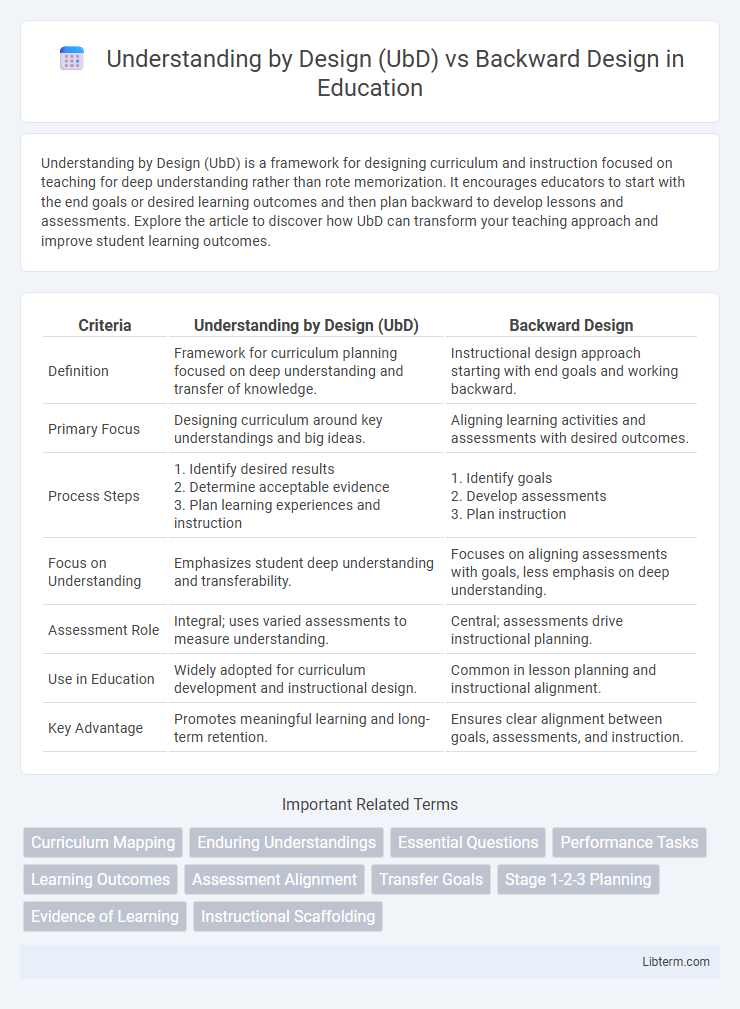Understanding by Design (UbD) is a framework for designing curriculum and instruction focused on teaching for deep understanding rather than rote memorization. It encourages educators to start with the end goals or desired learning outcomes and then plan backward to develop lessons and assessments. Explore the article to discover how UbD can transform your teaching approach and improve student learning outcomes.
Table of Comparison
| Criteria | Understanding by Design (UbD) | Backward Design |
|---|---|---|
| Definition | Framework for curriculum planning focused on deep understanding and transfer of knowledge. | Instructional design approach starting with end goals and working backward. |
| Primary Focus | Designing curriculum around key understandings and big ideas. | Aligning learning activities and assessments with desired outcomes. |
| Process Steps |
1. Identify desired results 2. Determine acceptable evidence 3. Plan learning experiences and instruction |
1. Identify goals 2. Develop assessments 3. Plan instruction |
| Focus on Understanding | Emphasizes student deep understanding and transferability. | Focuses on aligning assessments with goals, less emphasis on deep understanding. |
| Assessment Role | Integral; uses varied assessments to measure understanding. | Central; assessments drive instructional planning. |
| Use in Education | Widely adopted for curriculum development and instructional design. | Common in lesson planning and instructional alignment. |
| Key Advantage | Promotes meaningful learning and long-term retention. | Ensures clear alignment between goals, assessments, and instruction. |
Introduction to Understanding by Design (UbD)
Understanding by Design (UbD) is an educational framework developed by Grant Wiggins and Jay McTighe that emphasizes planning curriculum by starting with the desired learning outcomes. The approach prioritizes identifying clear goals, determining acceptable evidence of learning, and designing instructional activities that align with these outcomes. UbD differs from Backward Design by offering a more detailed, structured process that enhances clarity and depth in curriculum development.
What Is Backward Design?
Backward Design is an educational planning approach that starts with identifying desired learning outcomes and goals before developing assessments and instructional activities. It emphasizes aligning curriculum, teaching methods, and assessment to ensure students achieve specific understanding and skills. Understanding by Design (UbD) is a framework developed by Grant Wiggins and Jay McTighe that utilizes Backward Design principles to promote deeper learning and transfer of knowledge.
Core Principles of UbD
Understanding by Design (UbD) centers on defining clear learning outcomes and designing curriculum backwards from those goals to ensure deep comprehension rather than surface knowledge. The core principles of UbD emphasize identifying desired results, determining acceptable evidence of learning, and planning instructional activities accordingly. Unlike traditional Backward Design, UbD uniquely integrates the development of understanding with critical thinking and transfer of knowledge in diverse contexts.
Key Features of Backward Design
Backward Design centers on three key stages: identifying desired learning outcomes, determining acceptable evidence of mastery, and planning instructional activities aligned with those goals. This framework prioritizes clear goals and assessment criteria before designing curriculum content or teaching methods. By emphasizing outcome-based planning, Backward Design ensures instruction is purposeful and assessment-driven, enhancing student understanding and performance.
UbD vs Backward Design: Conceptual Differences
Understanding by Design (UbD) emphasizes developing deep comprehension and transferable knowledge through a three-stage process: identifying desired results, determining acceptable evidence, and planning learning experiences, while Backward Design primarily focuses on starting with end goals to plan instruction. UbD integrates inquiry-based learning and assessment alignment to foster critical thinking, whereas Backward Design centers more narrowly on aligning assessments with learning objectives. The key conceptual difference lies in UbD's broader emphasis on fostering enduring understanding beyond mere performance outcomes.
Step-by-Step Process Comparison
Understanding by Design (UbD) and Backward Design both emphasize starting with desired learning outcomes, but UbD uses a three-stage framework: identifying desired results, determining acceptable evidence, and planning learning experiences, while Backward Design primarily focuses on defining goals, assessment methods, and instructional activities. UbD integrates formative assessments throughout the units to ensure ongoing feedback, whereas Backward Design may place more emphasis on summative assessments aligned to objectives. The step-by-step process in UbD is structured to promote deeper comprehension by continually aligning teaching methods with targeted understandings and skills.
Benefits of Implementing UbD
Understanding by Design (UbD) emphasizes teaching for deep comprehension by structuring curriculum around essential questions and big ideas, enhancing student engagement and critical thinking skills. Implementing UbD fosters clearer learning objectives aligned with assessments, ensuring instruction is purposeful and targeted toward mastery of content. This approach supports differentiated instruction by identifying desired results first, allowing educators to develop flexible pathways that meet diverse learner needs effectively.
Advantages of Using Backward Design
Backward Design prioritizes outcome-focused curriculum planning by starting with clear learning goals, which ensures alignment between objectives, assessments, and instructional activities. This approach enhances teaching effectiveness by concentrating efforts on what students should master, leading to improved student understanding and retention. Its strategic framework facilitates transparent evaluation criteria, promoting consistent measurement of student progress and curricular adjustments based on performance data.
Common Challenges and Solutions
Common challenges in Understanding by Design (UbD) and Backward Design include aligning learning objectives with assessments and ensuring instructional activities effectively support desired outcomes. Both approaches often face difficulties in clearly defining measurable goals and anticipating student misconceptions during planning. Solutions involve collaborative curriculum design, ongoing formative assessment, and professional development focused on refining assessment criteria and instructional strategies.
Choosing the Right Approach for Effective Curriculum Planning
Understanding by Design (UbD) emphasizes deep learning through the identification of desired learning outcomes, while Backward Design focuses on starting with the end goals to shape assessments and instructional activities accordingly. Selecting the right approach depends on educators' priorities: UbD suits those aiming for conceptual understanding and transfer of knowledge, whereas Backward Design is effective for creating structured, goal-oriented curricula with alignment between objectives, assessments, and instruction. Integrating elements from both frameworks enables more effective curriculum planning that balances clear objectives with meaningful student understanding.
Understanding by Design (UbD) Infographic

 libterm.com
libterm.com